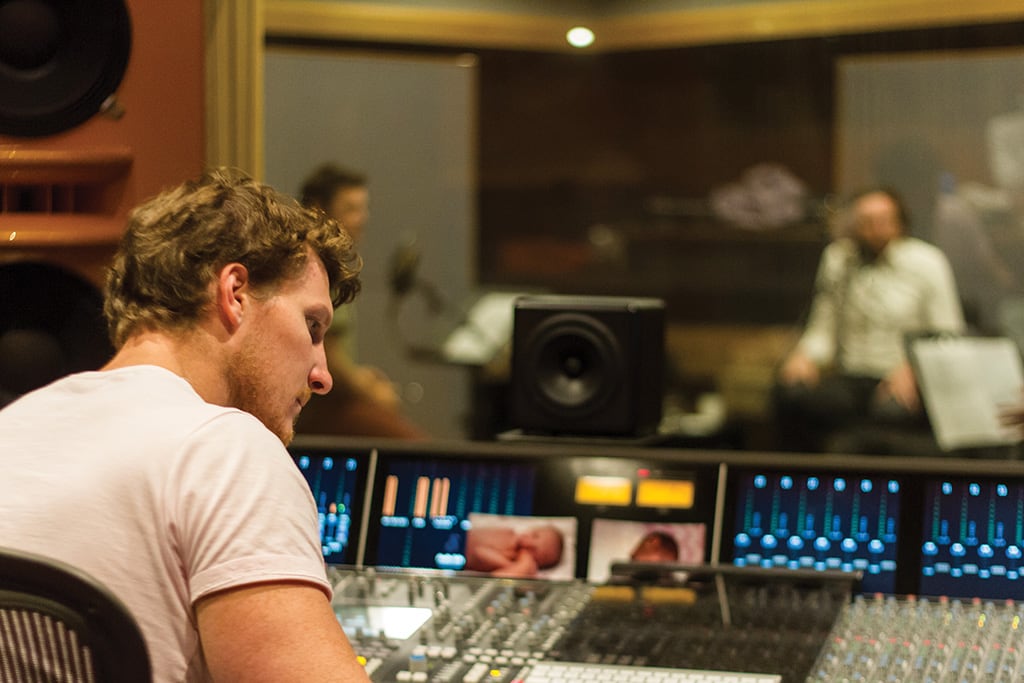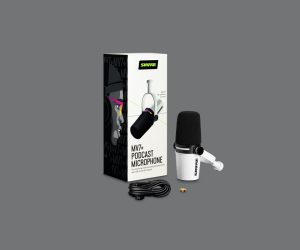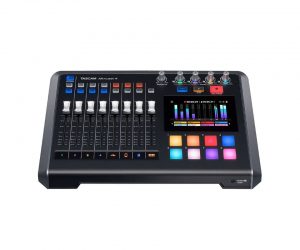
How to Produce a Podcast: Crawf & Hirdy
What better way for Shane Crawford to establish himself as more than AFL’s live-in larrikin, and James Hird to re-emerge from the supplements saga, than via a podcast. We stopped by Ginger Studios to get some tips on podcasting like a pro.
“Eight of nine,” Shane Crawford reminds me, when I short change how many tips he and fellow podcast host, James Hird, got right in the first round of the 2018 AFL season. It’s been a ripping start for the pair on both the tipping and podcast charts. They’re barely into the first couple of weeks of shows and the Crawf & Hirdy podcast is kicking goals.
Like many podcasts, there’s no financial backing behind this venture other than a couple of bucks from the local panel shop. It’s purely independent; no Channel Nine, no Triple M. While podcasts have long matured to being more than just a cheap outlet for opinionated people, there’s still room for a couple of guys to get together around some mics and chinwag about a topic they love for an hour. In this case, they’ve also enlisted Ralph Horowitz, a veteran of radio and TV sports broadcasting to keep the show moving.
It’s still early days, and when I meet the three of them at Ginger Studios in Cremorne, they’re blazing through a double taping because Crawford has to head overseas the next day to interview The Rock for The Footy Show. He’s a busy personality, and they’ve set themselves an ambitious schedule of two shows per week. One as a wrap up of the highlights, and one to make predictions regarding the coming week.
“I’ve been wanting to do a podcast for a while and just hadn’t had the time to commit to it,” said Crawford; who seems like he’s barely squeezing it in now. “I was keen to just talk about footy.” It’s important for Crawford, who’s built a reputation as a larrikin and often gets pigeon-holed in that role on The Footy Show. For a guy who was one of the ‘brains’ of footy on the field, he’s eager for people to realise he’s got a mind for analysis off it, too. Likewise, this is the first time James Hird has stepped back into any sort of limelight since the Essendon supplements saga. This allows him control over his return to the footy media circus. Both of them have a lot to gain from the venture, and not much to lose.
“I wasn’t really looking for it when Crawf rang me,” said Hird. “It was a chance to do something in a relaxed environment with someone you like, without someone else telling us what we had to talk about, or how. That’s the appeal.”
“It worked out perfectly,” agreed Crawford. “We’ve had a lot of fun dissecting a lot of different games and teams. We do go off track and lose our direction at times, but that’s normally my fault.”
They haven’t abandoned what’s made them popular. Rather, the podcast strikes a balance of in-depth, long-form football analysis; off-topic stories like Crawford hanging upside down naked ‘like a fruit bat’ as a young footballer/model; and broaches serious topics like Hird’s frank discussion about his own depression. As for a formula, they don’t really have one. “I don’t think there’s any formula for a podcast, is there?” asked Hird. “That’s why they’re so good, because there is none. We’ve all been in football a long time. A good podcast from our point of view is about simply being authentic and talking from our experiences.”
ENGINEERED TO PERFECTION
Helming the recording and distribution side is Ginger Studios’ owner, Jimi Wyatt. While podcasts can often be as simple as setting up a Zoom recorder or Røde USB mic, Crawford chose to work at Ginger for a few reasons. Firstly, he’s worked with Jimi before and knows he’s “extremely professional. We wanted to come together to record it in a single place, which is a great way to connect and build up our relationship and rapport. You can also ring in from anywhere in the world here. It works extremely well and that’s the way we’re going to continue to do it.”
Recording a podcast in a show format like this is all about preparation and expediency. Often, the show they’re recording mid-morning has to be uploaded in time to catch listeners on the drive or train ride home. “With the turnaround time on the show, I need it to be as close to automated as possible, without being so slap-dash that you don’t check it,” explained Wyatt, who shared a few tricks he implements to make sure it all goes off without a hitch.
THE TRIANGLE FORMATION
Wyatt sets up the trio in a triangular formation in the centre of Ginger Studio’s main live room. He places baffles behind each host and turns Crawford and Hird towards each other. “James and Shane tend to talk to each other more,” explained Wyatt. “Having them face each other means they have less time off-axis from their microphone.”
Wyatt uses AKG C414 condensers for Crawford and Horowitz, and a Wunder Audio CM7 FET for Hird. He says the different mics help the listener distinguish each voice. “Shane and Ralph sound very different to one and other,” explained Wyatt. “Shane is a little lower and Ralph has a little more rasp to his voice, so they don’t need to be on different voice microphones. The CM7 really suits James and helps distinguish his voice.”
UNLOCK DSP FROM THE CLOUD
Wyatt’s Pro Tools template already has the voice-over, intro and outro music ready to go. He uses all stock Pro Tools HDX powered plug-ins. “I don’t need any colour from a UAD plug, what I really need is DSP I can monitor through,” he explained. “I also don’t want to use native plugs because as soon as you put the record arm on, they can go blind. DSP just makes the show faster and smoother.” With everything native to Pro Tools, if he’s on holidays, his assistant can simply load up the same template and plug-ins via iLok’s cloud licensing.

A LITTLE PROCESSING, MULTIPLE TIMES
Speed is key, so Wyatt does some compression and EQ on the SSL Duality console before hitting Pro Tools. “It’s a quick attack on the compression, to make sure they don’t blow me out,” said Wyatt. “Both James and Shane get de-essed before I get into the DAW. Then I’m doing a little bit of downward expansion in Pro Tools. I use it rather than gating because there’s that possibility you miss something, and it’s a little more ‘musical’. I add a little limiting and more de-essing in Pro Tools. It’s about being careful with compression because it’s multiplicative rather than additive. I’m monitoring through all of that.
“Then on the master bus there’s another de-esser and a limiter just to keep the show at a consistent volume. That way I don’t have to spend two to three hours at the end doing lots of fader rides. Overall it’s a reasonably large amount of compression. I’m using downward expansion so I can limit more at the end and it doesn’t pull up that room ambience or have the guys in each other’s microphones.
CUT THE AMBIENCE, NOT THE MIC
Wyatt takes a relatively straightforward approach, with barely any edits. “The show is like an hour-and-a-half of good jazz improvisation,” describes Wyatt. “Every bit’s valuable and there’s no need to cut anything out. In fact, it’s very hard to get an edit point, because their chemistry is so good they naturally link over the top of one another. They work like a band works. I just haven’t worked out who the drummer is yet!
“Obviously you go back through it to some reasonable level of detail but it’s a weekly show where whoever is first to the news generally gets the most listeners.”
Crawford prefers to sit on a drum throne, but even with WD-40, they can occasionally squeak when you turn on the top. Wyatt drops markers so he knows where to come back and clean up the take. However, rather than cleaning it up in the offender’s mic, he’ll pull it out of the other two microphones: “A squeaky chair in the close mic is not as bad as a squeaky chair in the room mics, because it can be disengaging for the listener if they suddenly hear the environment.”
PUT IN THE WORK EARLY
Wyatt: “I always start to record really early, while they’re sitting around talking about the week, because it gives me a chance to have a look and see how hot the guys are. It’s okay if you have to move your gain pot. Just don’t do it while someone’s delivering a particular line. Make a marker that says you’re going to gain this a little bit up or down, but be okay to move with how that person is working on the day.”
RELYING ON YOUR SAFETY
Wyatt runs a separate backup coming straight out of the desk and into an Apogee Element interface into a laptop running Logic. It sits behind him, and just to the left, so he can check that the transport is still running in the control room window reflection. While backups may never get used, Wyatt’s saved his hide right from the get-go: “On the first show, I had done a late session the night before, and had the converters set at the wrong rate. I recorded the first part of the session and they sounded like chipmunks, but I picked it up within a few minutes. I dropped in the first couple of minutes from the backup, and it was all fine. I’d be lost without the safety recording. Even though I’ll delete it at the end of the day, having some kind of safety is important. You’re not doing your job properly if you have to say to the artist, ‘Hey, I need you to go back into the studio and punch-in.’ It needs to be done in a way where you make it so easy for them that they just walk in/walk out.”
KEEP IT COMFORTABLY LOUD
There’s no real loudness standards for podcasts yet. So Wyatt strikes a balance between loudness and comfort, keeping it around -14LUFS in short term loudness. “I try not to deafen anybody, but it’s not radio so you can be louder,” he explained. “I don’t need it to be crazy loud, and because it’s just speech it tends to be a lot more consistent in terms of its volume than music.
“The show will generally be out within 45 minutes of recording, and it could take between 10 minutes and two hours to appear on iTunes, depending on whether they refresh their feeds. We use a paid-for podcasting host service called Blubrry, which allows the guys to control any advertising.”
LOG THE BEST BITS
During the session, Wyatt sits there with a clipboard, which wasn’t his notes on the edit, but his short-list of the most interesting bits. In the age of doing-it-all, Wyatt has also assumed the responsibility of uploading the podcast, which requires a written blurb. “I write show notes so something comes up along with the upload,” he explained. “It gives a compelling reason for someone to listen, especially if they’re going back through the catalogue when it might be old news. I try to include the stuff that’s not so much around the week-to-week discussion, things like how to do goal-kicking training under pressure, or strategies teams might employ when they get into an unwinnable position.”
















RESPONSES